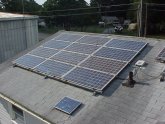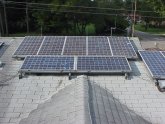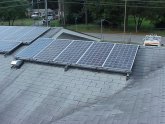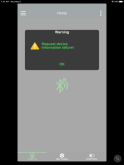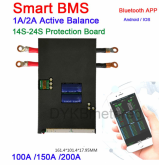You are using an out of date browser. It may not display this or other websites correctly.
You should upgrade or use an alternative browser.
You should upgrade or use an alternative browser.
looking for a good quality bms for my large 14s system
- Thread starter Dacflyer
- Start date
Might want to check out this thread if anyone decide on this bms. This looks like the same but maybe it was improved.

 diysolarforum.com
diysolarforum.com

New BMS from IC GOGOGO Store / E&J Technology Group
I talked to the guys from Chargery, (their e-commerce lines are called on AliExpress "IC GOGOGO Store" on Alibaba E&J Technology Group) and they have new type BMS!! It is available for shipment!! It ain't the cheapest option, price start at $95 Mine, the 24S 1A 300A, is $119.28 I'll update...
GXMnow
Solar Wizard
- Joined
- Jul 17, 2020
- Messages
- 2,710
That is the same JK type that I have. The real 200 amp with 2 amp balancing is just under $200 US depending on the shipping etc. I got mine for $176.00 plus an import and shipping charge. If you read the specs, the highest one now is still only rated for 200 amp continuous. But you can tell it to allow an over current for several minutes. And they claim it can take 300 or 400 amps now. From the specs I can find, I don't think the hardware got any change, just a new spec sheet with the higher rating.
Where did you order them JK BMS's ?
BMS 14S 24S Bluetooth APP JK 16S 1A 2A Active Balance Battery Protection Board for sale | eBay
Find great deals on eBay for BMS 14S 24S Bluetooth APP JK 16S 1A 2A Active Balance Battery Protection Board. Shop with confidence.
www.ebay.ca
Ok,, I'm looking at the B2A24S-15P
I'm Figuring that the more strings i have the load will be shared among the strings.
My inverter is fused for 100A,
So if 2 strings, 50A is shared and 3 strings then about 33A is shared ?
Can the app handle more than 1 app ? I'd have a max of 6 units possibly..possibly.
I'm Figuring that the more strings i have the load will be shared among the strings.
My inverter is fused for 100A,
So if 2 strings, 50A is shared and 3 strings then about 33A is shared ?
Can the app handle more than 1 app ? I'd have a max of 6 units possibly..possibly.
GXMnow
Solar Wizard
- Joined
- Jul 17, 2020
- Messages
- 2,710
When the App starts, it comes up with a list window, but I only have one, the name appears and I have to click on it. You can rename it so they don't all come up with the same name.
Mine is the 20P for 200 amp rating.
If you have 2 strings, they will share the current, but don't bet on the current being a perfect balance. Even a tiny difference in cell internal resistance and cabling etc. could throw it off a bit. Always try to make them match as close as possible, but if you expect to get 100 amps, make sure each string can take 75 amps. My 2 strings are fused at 125 each, and the whole bank is fused at 150. Last time I checked with the clamp amp meter, they were only 2 amps different at 31 and 29 amps when I was pulling 60 amps. That is excellent balance at about 3% error, but it could easily be a lot worse.
Mine is the 20P for 200 amp rating.
If you have 2 strings, they will share the current, but don't bet on the current being a perfect balance. Even a tiny difference in cell internal resistance and cabling etc. could throw it off a bit. Always try to make them match as close as possible, but if you expect to get 100 amps, make sure each string can take 75 amps. My 2 strings are fused at 125 each, and the whole bank is fused at 150. Last time I checked with the clamp amp meter, they were only 2 amps different at 31 and 29 amps when I was pulling 60 amps. That is excellent balance at about 3% error, but it could easily be a lot worse.
I had two of these B2A24S-15P, one on each 16S string parallel. You rename them at the start and then you can monitor them individually.Ok,, I'm looking at the B2A24S-15P
I'm Figuring that the more strings i have the load will be shared among the strings.
My inverter is fused for 100A,
So if 2 strings, 50A is shared and 3 strings then about 33A is shared ?
Can the app handle more than 1 app ? I'd have a max of 6 units possibly..possibly.
Mine worked fine for the first 4-5 hours and then started to be incorrect numbers on the amps coming in and out. All my cells were fine.
I was one of the first one to try these out, they were just being produced. That was back in March 10/20.
After 14-15 hours as soon that the sun was shining and system was starting to charge for the day,
the one bms was really acting up and shut down and maybe 15 minutes after the other one did the same thing.
It kicked my inverter on and off repeatedly, from the grid on and off,.
So I sent them back.
I now have the two amp active balancer from JK, with the same setup as the bms and they work fine.
If I was to put a bms again I would go with the tinybms.
Attachments
GXMnow
Solar Wizard
- Joined
- Jul 17, 2020
- Messages
- 2,710
My B2A24S-20P has been working fine for about 2 months so far, no issues at all. I did measure the voltage and current with my Fluke and used the calibrate feature to dial it in. It holds within 0.1 volt and amp except for the ripple current from the Schneider makes the value bounce around a little, but the long term average is pretty accurate. I will certainly let the forum know if it does act up on me. The highest current I have run through it was about 80 amps and it did get a little warm, but not bad considering the air around it was over 100F. I was still able to hold my hand on it, and the internal temp sensor was reporting just over 40C. The battery bank got up to just 35C I have the dialed back to about 40 amps now while the grid is up because I don't want to run the batteries below 60% on the daily cycles. With the lower currents and the cooler weather (only mid 90'sF instead of 115F) the battery is not even getting up to the garage air temp during the day. The BMS is just barely warn to the touch below 30C. I worked a solid 10 hours the last two days so I don't feel like doing the F-C conversions. Got another 8 am start tomorrow. It is good to be working a bit again, but after not working a few weeks, my body was not ready for climbing in walls and pulling cables all day.
ArthurEld
Solar Wizard
I would have bought the Heltec 200a w/2a active balance if it would work with 4s and 8s.
14s to 24s is pretty good but I wanted to mess with 12 volt and 24 volt while I put my battery packs together.
Then I would also be able to use it for 48 volt if I decided it was up to the task.
There are at least 4 people on this forum that have used that BMS. And 2 of them are reporting failure.
One thing about Tiny BMS that caught my attention is their CAN bus information. Many BMSs mention CAN but you get the impression they don't know if/how it works. I contacted the company that makes Tiny BMS and asked them about communicating with Sol-Ark 12K and they said they have not done any testing with it. But I did see mention somewhere that they provide some kind of CAN bus setup service for a fee. I will inquire about the CAN setup or programming service to see what they say.
I also talked to Sol-Ark tech support about the CAN communication and they recommended Batrium Watchmon4
They said that it is a very good BMS that will keep the cells balanced. Sol-Ark also said they are working with Batrium. So, Batrium is probably the best route for me if I want CAN bus communication.
I am still undecided. I need BMSs for four 48v battery packs. The only way I am going to spend 1000s of dollars on BMSs is if someone guaranties that they will communicate with my hybrid inverter without destroying something. Batrium also uses some kind of master BMS and slave BMSs which I assume keeps the battery packs balanced to each other. I haven't verified that though. It is another subject that I need to figure out.
Sol-Ark highly recommended using a good balancer so the BMS never needs to disconnect the battery. They said disconnecting the battery while it is charging or discharging is very hard on the Sol-Ark.
14s to 24s is pretty good but I wanted to mess with 12 volt and 24 volt while I put my battery packs together.
Then I would also be able to use it for 48 volt if I decided it was up to the task.
There are at least 4 people on this forum that have used that BMS. And 2 of them are reporting failure.
One thing about Tiny BMS that caught my attention is their CAN bus information. Many BMSs mention CAN but you get the impression they don't know if/how it works. I contacted the company that makes Tiny BMS and asked them about communicating with Sol-Ark 12K and they said they have not done any testing with it. But I did see mention somewhere that they provide some kind of CAN bus setup service for a fee. I will inquire about the CAN setup or programming service to see what they say.
I also talked to Sol-Ark tech support about the CAN communication and they recommended Batrium Watchmon4
They said that it is a very good BMS that will keep the cells balanced. Sol-Ark also said they are working with Batrium. So, Batrium is probably the best route for me if I want CAN bus communication.
I am still undecided. I need BMSs for four 48v battery packs. The only way I am going to spend 1000s of dollars on BMSs is if someone guaranties that they will communicate with my hybrid inverter without destroying something. Batrium also uses some kind of master BMS and slave BMSs which I assume keeps the battery packs balanced to each other. I haven't verified that though. It is another subject that I need to figure out.
Sol-Ark highly recommended using a good balancer so the BMS never needs to disconnect the battery. They said disconnecting the battery while it is charging or discharging is very hard on the Sol-Ark.
ArthurEld
Solar Wizard
It's a hybrid grid tied inverter/charge controller. https://www.sol-ark.com/sol-ark-12k/Arthur >> What is SOL-ARK ?
Here is Tiny BMS - https://energusps.com/shop/product/tiny-bms-s516-150a-750a-36
Last edited:
GXMnow
Solar Wizard
- Joined
- Jul 17, 2020
- Messages
- 2,710
With my JK BMS, It does not talk directly to my Schneider inverter, but now that I have been up and running a few weeks, I can honestly say I don't think it is a problem. I set the BMS still well in safe limits of each cell, and then set the inverter/charger even further inside of the safe area. As long as you are not trying to get every last watt hour out of the cells on a regular basis.
The inverter/charger just does it's thing and the full pack voltage is kept within safe limits.
The BMS does it's thing, and works to balance the cells. If any cell can't stay in balance and does end up going too high or low in voltage, then it will open and shut down the system. It may not be graceful, but it will protect the system. This should only happen if a cell is actually going bad or there is a bad connection in the system. The only real advantages of having the BMS talk to the inverter/charger would be that it could do a softer shut down when there is a problem, and/or it could see a more accurate state of charge if the BMS does good coulomb counting. On a 14S (or 16S) you can leave your full charge voltage a volt low, and low batt cut off 2 or even 3 volts high and the cells can get pretty far out of balance without causing a problem. Monitor the cells in the BMS and see if they are holding or drifting out of balance. If they can't hold balance, you should look into why. More balance current can help a small error in the matching of the cells, but a weak cell bank is going to both charge and discharge faster. If you consistently see the same cell going higher while charging, and lower while discharging, then you know that cell (or group of parallel cells) has less capacity than the others. And if you see one that stays lower while charging, and hangs higher while discharging, than that one has more capacity. If you run a few cells in parallel, you should be able to find a strong cell and a weak cell to put in a group together to average it out. If you find 14 weak cells, put one in each group of a 14S pack. The total amp hour of each group in a series string should match as close as possible.
The inverter/charger just does it's thing and the full pack voltage is kept within safe limits.
The BMS does it's thing, and works to balance the cells. If any cell can't stay in balance and does end up going too high or low in voltage, then it will open and shut down the system. It may not be graceful, but it will protect the system. This should only happen if a cell is actually going bad or there is a bad connection in the system. The only real advantages of having the BMS talk to the inverter/charger would be that it could do a softer shut down when there is a problem, and/or it could see a more accurate state of charge if the BMS does good coulomb counting. On a 14S (or 16S) you can leave your full charge voltage a volt low, and low batt cut off 2 or even 3 volts high and the cells can get pretty far out of balance without causing a problem. Monitor the cells in the BMS and see if they are holding or drifting out of balance. If they can't hold balance, you should look into why. More balance current can help a small error in the matching of the cells, but a weak cell bank is going to both charge and discharge faster. If you consistently see the same cell going higher while charging, and lower while discharging, then you know that cell (or group of parallel cells) has less capacity than the others. And if you see one that stays lower while charging, and hangs higher while discharging, than that one has more capacity. If you run a few cells in parallel, you should be able to find a strong cell and a weak cell to put in a group together to average it out. If you find 14 weak cells, put one in each group of a 14S pack. The total amp hour of each group in a series string should match as close as possible.
ArthurEld
Solar Wizard
I am trying to figure out the most graceful way to stop the charging or discharging if my BMS detects a problem.It may not be graceful, but it will protect the system.
It seems the easiest way is to disconnect the battery. Is that what you do?
Of course I plan to set up my system so that the BMS never detects a problem. I don't need to go near the limits of my batteries.
And I plan to use a balancer.
Your BMS is the least expensive, simplest and nicest looking BMS I have seen. It has the balancer and the app looks good. But I don't mind spending more money if it will protect my system better.
And I would be more comfortable stopping the charge controller instead of disconnecting the battery. Communicating with my hybrid inverter/charge controller seems like the most graceful way to do that. It might be possible to shut down the charge controller through my hybrid inverter app. I think I heard that possibility mentioned somewhere. I will look into that.
GXMnow
Solar Wizard
- Joined
- Jul 17, 2020
- Messages
- 2,710
There is a beeper inside the unit, it beeps each time I connect or make a change in the UI, so I guess it could beep on a warning, but I have never had it error on anything yet. Next time I have my XW-Pro shut down for a while, I can try changing the cutoff voltage and see if it does anything odd when it has to open the load. Once I have my PLC up and running, I was thinking of having an input check for voltage across the BMS. If it sees more than 1 volt, it can flag me that something is wrong. Of course it needs to be isolated, and limited, as if it does go open, it could then have 58 volts across it.
ArthurEld
Solar Wizard
GXMnow
Solar Wizard
- Joined
- Jul 17, 2020
- Messages
- 2,710
That is actually the older case, the new case is cast aluminum and covers the caps and bluetooth board. it has 5 tiny holes on the side. I made them bigger. I was not the first to do it, it was in a review of the board, a guy said he drilled the holes out to get more range.
Well, I think I am gonna bite the battery cable and buy a few of these to try.. If i don't like them, I can always resell em fast since they'd be here in the states,,,lol
I hope you won't mind if i ask you more questions on these once i get them in and hooked up..
I hope you won't mind if i ask you more questions on these once i get them in and hooked up..
Similar threads
- Replies
- 11
- Views
- 575
- Replies
- 11
- Views
- 564
- Replies
- 4
- Views
- 174
- Replies
- 1
- Views
- 200



